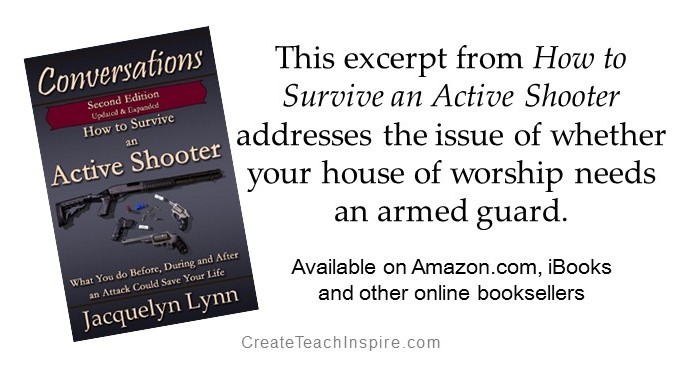Does your house of worship (church, synagogue, temple, mosque, etc.) need an armed guard to protect members from an active shooter?
 This excerpt from How to Survive an Active Shooter addresses some of the issues related to protecting houses of worship from possible attacks. It is geared primarily to organizations that do not have the budget to hire outside security services.
This excerpt from How to Survive an Active Shooter addresses some of the issues related to protecting houses of worship from possible attacks. It is geared primarily to organizations that do not have the budget to hire outside security services.
Note: the voice of this blog is the expert source quoted in How to Survive an Active Shooter.
We understand this discussion will be scrutinized for practicality, morality, and legality issues. Let’s address them upfront.
First, practicality. If someone enters your place of worship with a gun, intent on shooting others, please identify every possible means to stop him. Don’t try to reason with him. He is already beyond reason.
Second, morality. There were no guns in Jesus’ day; however, there are references to weapons within the Bible. These can be interpreted many ways, and we’re not debating theology here. What’s important is that you do not clearly ban nor solicit the presence of weapons in a church.
Third, legality. Guns may be carried into a house of worship in 48 states. Several states require the permission of the house of worship first. If your church hosts a school, then other laws may apply. Learn the laws of your locality. The laws won’t protect you from the shooter, but they will determine what options you legally possess to stop one.
Could it happen at your house of worship?
Your odds of experiencing an active shooter event are minimal. According to a 2013 FBI study, houses of worship represented 3.8 percent of those events, with businesses at 45.6 percent and schools at 24.4 percent being the most frequent sites.
In the National Safety Council’s 2017 injury facts chart, which shows the most likely causes of injury, heart disease and cancer were the largest, at 1 in 7. Chronic lower respiratory disease was second, at 1 in 28. Assault by firearm was seventh, at 1 in 370, and includes accidents, suicides, and hunting incidents. Self-harm, unintentional poisoning, motor vehicle accidents, and falls were numbers three through six.
There are many other sources that identify your chances of dying by gunfire or a mass shooter, and in every case, the odds are minimal.
Many churches choose to do nothing or to use faith as their method of protection. While the statistics are in your favor, the approach isn’t practical—nor is it effective if an actual active shooter event emerges.
How do you prepare for an active shooter?
Active shooter preparation is not pleasant and creates anxiety within a church and among its members. The issue can divide on moral and political lines. Do not let your views on guns and “gun control” get in the way of effectively preparing your congregation or other group to survive an attack. We have to look at the way things are, not at the way we wish them to be. So let’s talk about the best way to deal with an active shooter.
There is only one effective way to deal with an armed person intent on shooting others and that’s with a gun. Active shooters generally attempt to avoid confrontation with armed persons. There have been events—the Clackamas Mall incident being the best documented—where the active shooter abandoned his goal or committed suicide once facing armed retaliation.
Don’t get me wrong—I am actually not advocating simply carrying guns to church. There is a grave danger in that, too. You need a plan.
So to protect yourself from an active shooter, consider first how to identify and handle an active shooter. Some common thoughts church members offer, whether good or bad, are:
- Do nothing;
- Pray;
- Post “gun-free zone” signs;
- Establish a group to protect the church;
- Train a group to protect the church.
Let’s go through them.
Should you do nothing and pray? Should you post “gun-free zone” signs?
Doing nothing and praying may work because the actual risk is minimal. Mathematically, if churches have 3.8 percent of the active shooter events and if we use the overly broad “death by firearm” category, your odds of dying at church by a firearm are about 1 in 10,000.
In 2012 and 2014, 80 people died each year of mass shooting events. That makes your odds of dying in a mass shooting event 80/323.1 million or 1 in over 4 million. If church is only 3.8% of those, then your odds are 1 in 105 million. I have full respect for any church that chooses to pray or to do nothing—with two caveats.
The danger of posting a gun-free zone sign is that a shooter wants to be unopposed. If you post a gun-free zone sign, then you have just volunteered your congregation for attack. Your goal is to dissuade the attacker—if he wishes to kill random people in numbers, then he will do so. You don’t want your church to be the target. The gun-free zone sign works against that goal. Posting that sign tells the shooter that this is a place where he can attack and be unopposed. It’s a welcome mat to him. Plus, it’s a wholly ineffective concept. If you believe that a person who has come to a building with the intent to kill, carrying weapons and ammunition with him, will look at a piece of paper saying “gun-free zone” and say, “Aw, shucks—gotta do it somewhere else now,” then I really wish I could live in that world with you. No law, no paper, no policy will stop a person intent on killing.
Should you establish a group to protect the church?
Establishing a group to protect the church is the next idea. I carry a weapon to church. I know what I would do if threatened. However, I also have one great fear that comes from knowing that there is no group training: What will the rest of the congregation do?
In an unprepared church, no one knows who is or is not armed. No one knows who is or is not trained. Let’s suppose twelve people oppose the shooter with their guns. What will the outcome be? Friendly fire deaths are more likely. Chaos and panic are more likely. How will the other eleven react to me? How will I react to them? Will any of us shoot each other, or miss the shooter and accidentally kill a member of the congregation? Leaving it all to chance is a dangerous move.
Further, we discussed the congregation. What about the people in other areas of the church? Do we have an ability to lock down the facility? Can we effectively reunite families after the event? How do we know what is happening across the entire facility—is possible that there is a shooter in the sanctuary, another in the school, and another in the kitchen?
Leaving everything to chance brings about its own risks and dangers. The possibility does exist that the presence of the firearms may cause more harm than good, even if used to protect the church. The active shooter will cause every person present to behave in a new and unexpected way. Movement will be unpredictable. The most dangerous person in the room may not be the active shooter but could become the well-meaning member of the congregation trying to stop him, but from a distance with a backdrop of dozens or hundreds of panicking people. Or it may be the very panicked individual trampling the children and elderly in an attempt to get away.
Should you train a group to protect the church?
Yes. The correct answer in preparing for the possibility of an active shooter is to train a group to protect the church. That is their role. Period. They do not pass collection plates. They do not participate in the choir. They do not hand out leaflets or food items. They do not assist in communion. They protect the church.
They should be trained together and, ideally, armed. Their existence should be known to the church membership through verbal communication, not published information. They should meet periodically to evaluate potential threats and vulnerabilities and be ready to address them. This can include theft, kidnapping, bombs, and other concerns of the church, as the church now has trained personnel working to establish secure surroundings. These are the people who will check for lights, dark areas, hiding spaces, and tripping hazards. They will know where to either sit or walk during each church activity. They should never be permitted to become a social club—they cannot simply chat amongst themselves during church gatherings. They must be either positioned or properly mobile to ensure the church is safeguarded.
This trained group can do more than just protect your congregation against an active shooter. It can help reduce your church’s vulnerability to the entire spectrum of threats from theft to safety to crime. It is the wisest approach to protect your church from every threat.
What about a situation where such a group does not exist but there are people who are carrying weapons?
If you are someone who carries a weapon to church to see to the safety of others, please consider your own tactics.
If you see a suspicious person, move close to him. The greater distance from the threat means the greater the chance that you could miss and hit someone or something else if you need to fire your weapon.
Think about your ammunition. Jacketed hollow point (JHP) bullets will impact your target, lose velocity, and begin to tumble. The odds of a second casualty from a through-and-through round are minimized with hollow point bullets. But remember that your adversary is probably shooting something else that will very likely pierce through a thin material or person and remain lethal—perhaps a full metal jacket (FMJ) round.
Consider where you sit. The shooter will likely engage from the main entry or center of the church. Be in the center of the church so that you can immediately respond. Sit on the end of your row or pew so that you can move quickly.
What’s the first step in training a group to protect your house of worship?
If you are preparing to train a group to protect the church, reach out to local law enforcement and security-trained members of your congregation and ask for advice. Document the plan so that new members can come on board quickly, and so that church leaders know the plan.
Some key things to consider in planning include the entries and exits, including windows, that may be used; how to lock down portions of the church facility during the event; alarm systems; best paths to achieve a rapid exit; what cover exists in what areas; how people can reach law enforcement; whether alarms or detection systems are needed; what hallways, tunnels, and other paths may add vulnerability or require coverage; how a shooter would escape; who could be taken hostage if a lockdown is not implemented.
Additional reading:
Why You Should Never Try to Call a Loved One During an Active Shooter Situation
Excerpt from How to Survive an Active Shooter discusses the option of fleeing
We are heartbroken every time a mass shooting occurs. We will let others discuss what might have been done to stop the perpetrator and what could be done to prevent similar events in the future. Our mission with How to Survive an Active Shooter is to give you information and tools to help you survive should you find yourself in an active shooter situation.
- 11 Characteristics of Successful Entrepreneurs - November 17, 2025
- Why the World Benefits from Billionaires - August 4, 2025
- Should You Use AI for Audiobook Narration? - July 28, 2025






